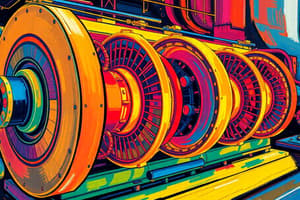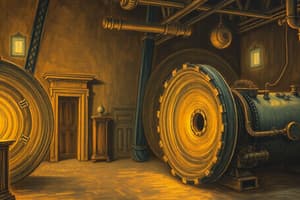Podcast
Questions and Answers
What causes electromagnetic induction to occur in a coil of wire?
What causes electromagnetic induction to occur in a coil of wire?
- High temperatures affecting the coil's electrical properties
- A steady magnetic field applied to the coil
- The presence of direct current in the coil
- Changing magnetic fields when the coil moves through a magnetic field (correct)
What type of current is generated when a magnet moves back and forth inside a coil of wire?
What type of current is generated when a magnet moves back and forth inside a coil of wire?
- Alternating current (AC) (correct)
- Direct current (DC)
- Constant current
- Transient current
What is the effect of alternating current (AC) on the magnetic field it generates?
What is the effect of alternating current (AC) on the magnetic field it generates?
- It has no effect on the magnetic field
- It grows, collapses, and reverses direction (correct)
- It remains constant over time
- It only grows indefinitely without collapsing
What is mutual inductance?
What is mutual inductance?
Which of the following is NOT a function of electromagnetic induction?
Which of the following is NOT a function of electromagnetic induction?
What is the SI unit of current?
What is the SI unit of current?
If an electric circuit has a potential difference of 1 volt, how much energy is used to move 1 coulomb of charge between two points?
If an electric circuit has a potential difference of 1 volt, how much energy is used to move 1 coulomb of charge between two points?
What is the term used to describe the flow of electrons through a circuit?
What is the term used to describe the flow of electrons through a circuit?
Which statement is true regarding the movement of electrons in an electric circuit?
Which statement is true regarding the movement of electrons in an electric circuit?
What is the unit of measurement for potential difference?
What is the unit of measurement for potential difference?
The charge on a single electron is approximately how much?
The charge on a single electron is approximately how much?
What occurs when the voltage in a circuit is increased to 50 kilovolts?
What occurs when the voltage in a circuit is increased to 50 kilovolts?
What is the relationship between current, charge, and time?
What is the relationship between current, charge, and time?
What is the SI unit of magnetic flux?
What is the SI unit of magnetic flux?
Which material type is characterized by a net magnetization even without an external magnetic field?
Which material type is characterized by a net magnetization even without an external magnetic field?
How is flux density defined?
How is flux density defined?
What happens to the magnetic field when electrons move through a conductor?
What happens to the magnetic field when electrons move through a conductor?
What effect does passing a current through a coiled wire have on the magnetic field?
What effect does passing a current through a coiled wire have on the magnetic field?
What is the strength range of Earth’s magnetic field?
What is the strength range of Earth’s magnetic field?
What is meant by electromagnetic induction?
What is meant by electromagnetic induction?
What type of material is known to be freely magnetized when placed in a magnetic field?
What type of material is known to be freely magnetized when placed in a magnetic field?
What does kV represent in an X-ray tube?
What does kV represent in an X-ray tube?
What effect does increasing the mA in an X-ray tube have?
What effect does increasing the mA in an X-ray tube have?
What does the exposure duration (s) refer to in an X-ray tube?
What does the exposure duration (s) refer to in an X-ray tube?
What are magnetic dipoles composed of?
What are magnetic dipoles composed of?
What is a magnetic domain?
What is a magnetic domain?
Which statement about magnetism is true?
Which statement about magnetism is true?
What happens to the molecular dipoles when magnetism is induced in a material?
What happens to the molecular dipoles when magnetism is induced in a material?
How is the magnetic field defined?
How is the magnetic field defined?
What is primarily necessary to understand the function and operation of diagnostic radiography equipment?
What is primarily necessary to understand the function and operation of diagnostic radiography equipment?
What does electromagnetic induction primarily assist in producing?
What does electromagnetic induction primarily assist in producing?
What is the relationship between electric current and magnetic fields?
What is the relationship between electric current and magnetic fields?
Which of the following components is associated with controlling an electrical supply?
Which of the following components is associated with controlling an electrical supply?
Which principle is fundamental to the nature of charge?
Which principle is fundamental to the nature of charge?
What is a primary function of components like X-ray tubes and image intensifiers?
What is a primary function of components like X-ray tubes and image intensifiers?
What does understanding the nature of charge help with in practically applied scenarios?
What does understanding the nature of charge help with in practically applied scenarios?
Which statement accurately describes electric current?
Which statement accurately describes electric current?
What role do virtual and on-campus simulations play in the learning objectives of this module?
What role do virtual and on-campus simulations play in the learning objectives of this module?
Which topic is NOT emphasized in the learning outcomes of this module?
Which topic is NOT emphasized in the learning outcomes of this module?
What is the relationship between the number of turns in the primary and secondary coils and the voltage in each coil?
What is the relationship between the number of turns in the primary and secondary coils and the voltage in each coil?
If a transformer has 25 turns in the primary coil and 75 turns in the secondary coil, what can be concluded?
If a transformer has 25 turns in the primary coil and 75 turns in the secondary coil, what can be concluded?
What type of transformer is used when the secondary coil has more turns than the primary coil?
What type of transformer is used when the secondary coil has more turns than the primary coil?
In a transformer with 50 primary turns and 100 secondary turns, what is the ratio of primary to secondary voltage?
In a transformer with 50 primary turns and 100 secondary turns, what is the ratio of primary to secondary voltage?
Using the formula $Np / Ns = Vp / Vs$, which variable is affected by changing the number of turns in the primary coil?
Using the formula $Np / Ns = Vp / Vs$, which variable is affected by changing the number of turns in the primary coil?
Flashcards
What is electric charge?
What is electric charge?
A fundamental property of matter that causes it to experience a force when placed in an electromagnetic field.
What is electric current?
What is electric current?
The flow of electric charge through a conductor, typically measured in amperes (A).
What is a magnetic field?
What is a magnetic field?
A region around a moving electric charge where magnetic forces are present.
What is electromagnetic induction?
What is electromagnetic induction?
Signup and view all the flashcards
What is an X-ray tube?
What is an X-ray tube?
Signup and view all the flashcards
What is a radiation detection device?
What is a radiation detection device?
Signup and view all the flashcards
What is magnetic resonance imaging (MRI)?
What is magnetic resonance imaging (MRI)?
Signup and view all the flashcards
What is radiation safety?
What is radiation safety?
Signup and view all the flashcards
What are assessment skills in radiation?
What are assessment skills in radiation?
Signup and view all the flashcards
What are the fundamentals of radiation?
What are the fundamentals of radiation?
Signup and view all the flashcards
Electrical Current
Electrical Current
Signup and view all the flashcards
Potential Difference
Potential Difference
Signup and view all the flashcards
Ampere (A)
Ampere (A)
Signup and view all the flashcards
Electrical Charge (Q)
Electrical Charge (Q)
Signup and view all the flashcards
Electron Volt (eV)
Electron Volt (eV)
Signup and view all the flashcards
Electron Flow
Electron Flow
Signup and view all the flashcards
Anode
Anode
Signup and view all the flashcards
Cathode
Cathode
Signup and view all the flashcards
kV (kilovoltage)
kV (kilovoltage)
Signup and view all the flashcards
mA (milliamperes)
mA (milliamperes)
Signup and view all the flashcards
s (exposure duration)
s (exposure duration)
Signup and view all the flashcards
Magnetism
Magnetism
Signup and view all the flashcards
Magnetic dipole
Magnetic dipole
Signup and view all the flashcards
Magnetic domains
Magnetic domains
Signup and view all the flashcards
Magnetic field
Magnetic field
Signup and view all the flashcards
Magnetic permeability
Magnetic permeability
Signup and view all the flashcards
What is magnetic flux?
What is magnetic flux?
Signup and view all the flashcards
What is flux density?
What is flux density?
Signup and view all the flashcards
What is a diamagnetic material?
What is a diamagnetic material?
Signup and view all the flashcards
What is a paramagnetic material?
What is a paramagnetic material?
Signup and view all the flashcards
What is a ferromagnetic material?
What is a ferromagnetic material?
Signup and view all the flashcards
What is a solenoid?
What is a solenoid?
Signup and view all the flashcards
Electromagnetic Induction
Electromagnetic Induction
Signup and view all the flashcards
Direct Current (DC)
Direct Current (DC)
Signup and view all the flashcards
Alternating Current (AC)
Alternating Current (AC)
Signup and view all the flashcards
Mutual Inductance
Mutual Inductance
Signup and view all the flashcards
Motor
Motor
Signup and view all the flashcards
Transformer
Transformer
Signup and view all the flashcards
Transformer voltage ratio
Transformer voltage ratio
Signup and view all the flashcards
Step-up transformer
Step-up transformer
Signup and view all the flashcards
Step-down transformer
Step-down transformer
Signup and view all the flashcards
Mutual induction
Mutual induction
Signup and view all the flashcards
Primary coil
Primary coil
Signup and view all the flashcards
Secondary coil
Secondary coil
Signup and view all the flashcards
Iron ring
Iron ring
Signup and view all the flashcards
Study Notes
Electricity & Magnetism Module
- This module covers electricity and magnetism, focusing on their applications in diagnostic imaging, specifically X-ray production.
Module Timeline 2024-25
- The module has a scheduled timeline, including lectures, seminars and assessment dates.
- Important topics like 'Skills for module completion', 'Radiation Protection', 'Fundamentals of Radiation' and 'Radiation Safety' are included.
- Virtual and on-campus simulations are part of the module.
- There is a timeline for mock assessments and a final MCQ examination.
Learning Objectives
- Learning objectives include defining the electromagnetic spectrum and its diagnostic imaging applications.
Today's Learning Outcomes
- Understanding charge's nature
- Grasping the principles of magnetism
- Understanding electric current flow
- Knowing the relationship between electric current and magnetic fields
- Understanding how electrical components control electrical supply
- Understanding how electromagnetic induction produces X-rays.
Diagnostic Radiography Equipment
- X-ray tubes, generators, and the X-ray circuit are essential components.
- Image intensifiers, TV systems, and IT systems are also critical to the process.
- Radiation detection devices and Magnetic Resonance Imaging (MRI) are used in diagnostic processes.
Charge
- Electrical charges exert forces on each other, even in a vacuum.
- These forces are mutual, equal, and opposite.
- Like charges repel; unlike charges attract.
- Demonstrated by the behaviour of small metal balls suspended by threads.
The Nature of Charge
- Two types of electric charge exist: positive and negative.
- The smallest unit of negative charge is the electron (e).
- The smallest unit of positive charge is the proton (p).
- The SI unit of charge is the Coulomb (C).
- One Coulomb represents the charge on 6 x 1018 electrons.
Influence on Mutual Forces
- The magnitude of attractive or repulsive forces depends on: -The inverse of the square of the distance between the charged bodies. -The magnitude of the individual charges. -The medium between the charges (maximum in a vacuum).
Electric Current Flow
- Electric fields cause charge movement within a circuit. -Charges move from cathode to anode in electric-circuit.
- Electric field strength describes the intensity at a particular location.
Current, Resistance
- The SI unit of electric current is the ampere (A).
- Charge (C) = Current (A) × time (s).
- Ohm's law states: V = IR (Voltage = Current × Resistance).
- 1 Ampere drives 1 Coulomb per second.
- Resistors control current supply to components.
- Resistance impedes electron flow within a material.
- A potential difference of 1 Volt drives a current of 1 Ampere through a conductor of 1 Ohm.
Capacitance
- A capacitor is a device that temporarily stores electric charge.
- Capacitance is the amount of charge a capacitor can hold per unit potential.
- Capacitance's unit is the farad (F).
- Factors affecting capacitance include electrode area, distance between electrodes, and dielectric constant.
Electrical Energy and Power
- Electrical energy enables electron movement.
- A potential difference drives current flow.
- Energy is used to keep electrons moving in one direction, overcoming resistance.
- Colliding electrons produce heat loss.
Electrical Power - the Watt
- Electrical power (Watts) equals voltage (Volts) × current (Amperes). This illustrates loss.
So, Why Do We Care?
- kV (Voltage): Accelerates electrons in X-ray tubes; crucial for X-ray production.
- mA (Current): Quantity of electrons passing through the X-ray tube; controlling exposure.
- s (Time): Exposure duration affecting the number of X-rays generated.
X-Ray Circuit, Transformers
- A schematic diagram of a simplified x-ray circuit is presented.
- Transformers use mutual induction to alter voltage for specific X-ray needs. Step-up/down voltage. Relationship between primary and secondary voltage and turns is presented.
Magnetism
- Magnetism is caused by moving electrical charges.
- In magnetic materials, electron circulation and spin (atomic dipoles) create magnetism.
- Materials form permanent magnets or magnetic behavior (temporary).
- Domains are regions of aligned atoms causing overall magnetization.
- Magnetic fields are the areas around magnets where magnetic effects are felt. Measured by flux and flux density.
- Types of magnetic materials exist; including diamagnets, paramagnets and ferromagnets.
Electromagnetic Induction
- Moving electrons inside a conductor create a magnetic field.
- Changing magnetic fields induce currents in other conductors.
- This effect is electromagnetic induction.
- Mutual induction in coils, leads to transformer.
- Induction is used in coils such as x-ray tubes.
Electromagnetic induction used in Transformers
- Transformers use mutual induction to transform voltage while keeping power constant.
- The ratio of primary to secondary voltage is dependent on the number of windings on both coils.
Summary
- High voltages are used in X-ray machines to accelerate electrons.
- Current and time affect X-ray photon production.
- Electric and magnetic fields are intrinsically linked.
- Electromagnetic induction generates high voltages for use in X-ray production.
Studying That Suits You
Use AI to generate personalized quizzes and flashcards to suit your learning preferences.




